Highlights from OECD's Australia report

While recent headlines have focused on the OECD’s passing comments on housing-debt risks in their recent 47-pager on Australia, the real meat and spuds in this great report is the analysis on, and recommendations for, Australia’s slipping productivity, innovation and inequality. We’ve pulled out some of the highlights and key charts from the report below, and the link to the original is at the bottom of the wire.
On Productivity and innovation
Working in an innovative start-up, it was encouraging to see so much of the report cover the need to harness Australia’s innovative industries to deliver much needed productivity growth. Here are some of the quotes:
“Productivity growth has slowed since its peak in the 1990s (Figure 2) but remains in line with its longer term average. Despite encouraging recent productivity growth, population aging (the number of Australians over 65 years of age will more than double by 2055) means the country’s growth prospects depend crucially on strong productivity growth which, in turn, requires greater capacity for absorbing and generating new innovations.”
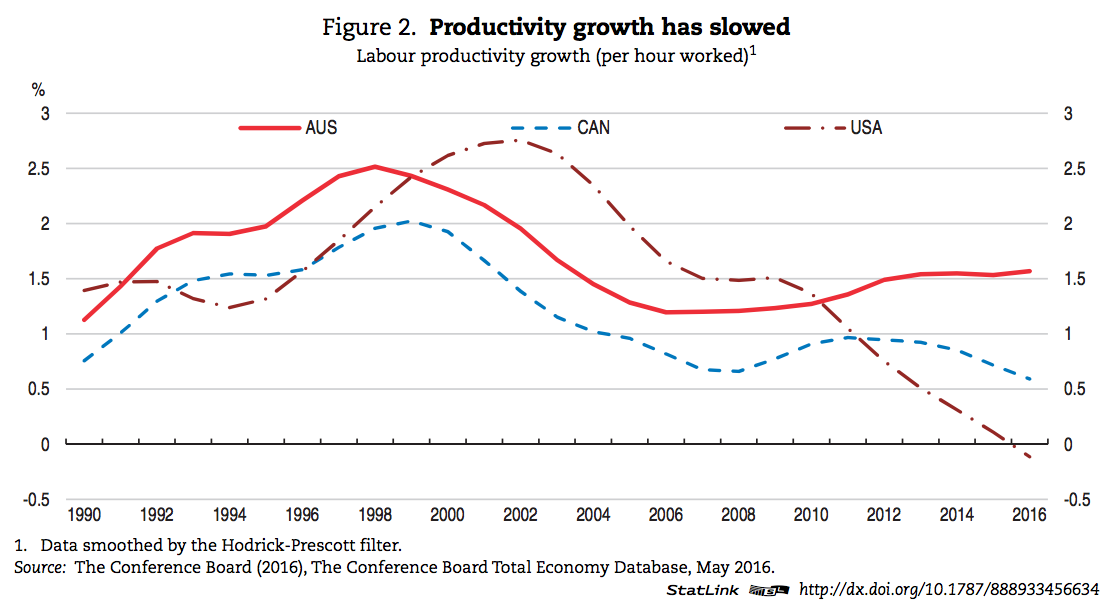
"Improving competition and other framework conditions that influence the absorption and development of innovation are key for restoring productivity growth. Innovation requires labour and capital markets that facilitate new business models. Productivity growth could be boosted through stronger collaboration between business and research sectors in R&D activity. The government’s reform programme, notably the National Innovation and Science Agenda, is providing welcome impetus to reform."

On recommendations:
- "Improve competition law, notably by strengthening the definition of abuse of dominant position
- Adjust insolvency legislation Increase labour mobility, for instance by lower interstate differences in education and training programmes Encourage market entry by innovative business.
- Use competition policy tools to combat resistance by incumbents and adjust sectoral regulation quickly as new firms and industries emerge
- Facilitate the entry of a fourth operator in mobile telephony via a spectrum auction"
- Encourage market entry by innovative business.
- Use competition policy tools to combat resistance by incumbents and adjust sectoral regulation quickly as new firms and industries emerge
- Facilitate the entry of a fourth operator in mobile telephony via a spectrum auction"
- Put a greater weight, as envisaged, on collaboration in university funding and develop a more coordinated approach to industry placements for research students to strengthen the linkages between research and business sectors Implement the common approach across public-sector research organisations for assessing research outcomes and impacts
- Develop a more integrated, “whole-of-government” approach to science, research and innovation and consolidate innovation support programmes"
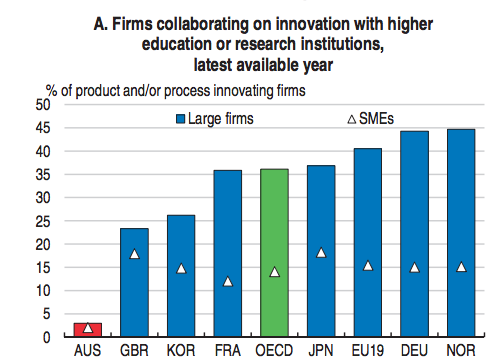
On the economy: "Well positioned to handle shocks"
The high household debt level has been well documented, and was a relatively small part of the report, which was overall reasonably sanguine. It did however warn of a “non-negligible risk of downturn” using its forecasting tools, though to bear in mind their ‘limited accuracy’… I’d recommend you read this in full, but here are some key quotes:
“Australia’s economy has enjoyed considerable success in recent decades, reflecting strong macroeconomic policy, structural reform and the long commodity boom. Living standards and well-being are generally high, though challenges remain in gender gaps and in greenhouse-gas emissions, and further challenges arise from population ageing. The economy is now rebalancing following the end of the commodity boom, supported by macroeconomic policies and currency depreciation. The strengthening non-mining sector is projected to support output growth of around 3% in 2018 and spur further reduction in the unemployment rate. Low interest rates have supported aggregate demand but are also ramping up risk-taking by investors and driving house prices and mortgage lending to historical highs."
“The economy is well positioned to handle shocks such as those described [below]. The speed and strength of the rebalancing processes in response to the end of the commodity boom auger well for the economy’s shock-absorbing capacity. In addition, Australia has more reserve capacity for monetary and fiscal stimulus than many other OECD economies:
- Dramatic house-price correction: A large drop off in house prices could cut household consumption and increase mortgage defaults
- Renewed plunge in global iron ore and coal prices: Further cost-savings and retrenchment of investment among mining companies with impact on jobs and incomes
“Australia’s fiscal position is strong and the current fiscal stance is appropriate given the outlook. According to a recent cross-country study (Fall and Fournier, 2015), debt could begin reducing output growth between 70-90% of GDP. This implies Australia, with gross debt at 44%, still has a significant margin to absorb shocks and actively stimulate growth. Indeed, the government could run a substantially larger deficit for some time without coming close to the limits suggested above (Figure 20). In this context, should the downside risks materialise, the authorities should actively use fiscal policy to support the economy, as they did in 2008-09.
Bearing in mind the limited accuracy, the emergence of peaks in the most recent data suggests there is a non-negligible risk of downturn.
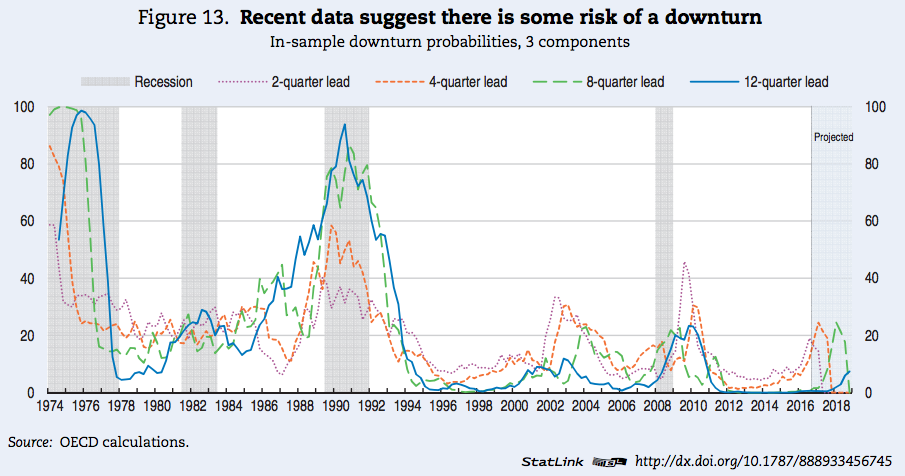
On inequality
The Gini coefficient is the most commonly used economic measure of inequality, and the data demonstrates that Australian inequality has risen steadily during the good years. the top quintiles have become wealthier faster than the rest. Interestingly the report recommends harnessing innovation, as well as social policies, as part of the solution:
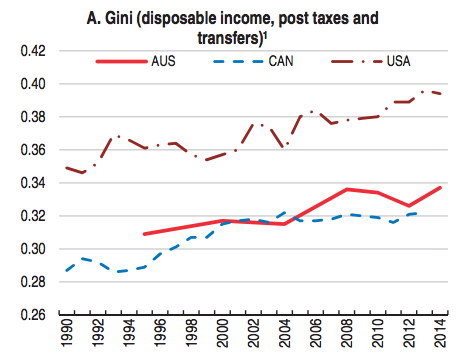
"Innovation policy can play an important role in tackling social issues. Innovation policy in Australia already incorporates considerations of the “wider good” by backing research with potential for significant social return, such as research in many areas of health care and innovations in education.
Links to reports, and report "wordle"
You can read the full report here: (VIEW LINK)
And the slide deck is here as well: (VIEW LINK)
I have produced the 'wordle' below which has taken all the text in the 47 pages of the OECD report, and counted how many instances there are of each word. This gives you a quick cross-section of dominant themes within the report, simply by looking at which words are the largest.
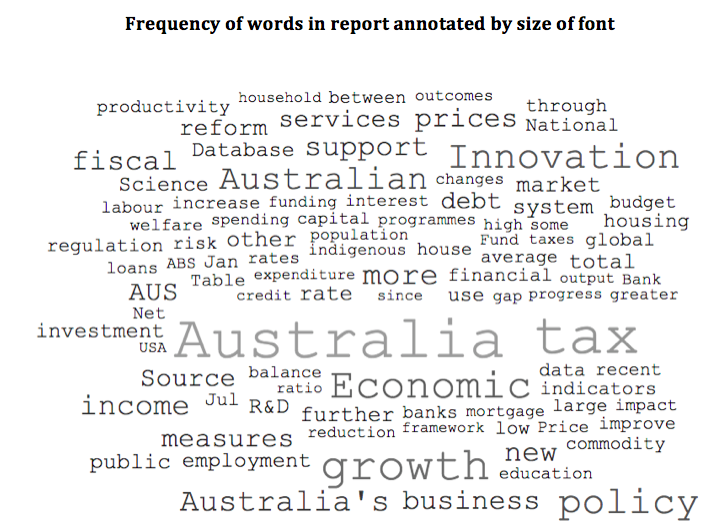
3 topics

Alex happily served as Livewire's Content Director for the last four years, using a decade of industry experience to deliver the most valuable, and readable, market insights to all Australian investors.
Expertise

Alex happily served as Livewire's Content Director for the last four years, using a decade of industry experience to deliver the most valuable, and readable, market insights to all Australian investors.
